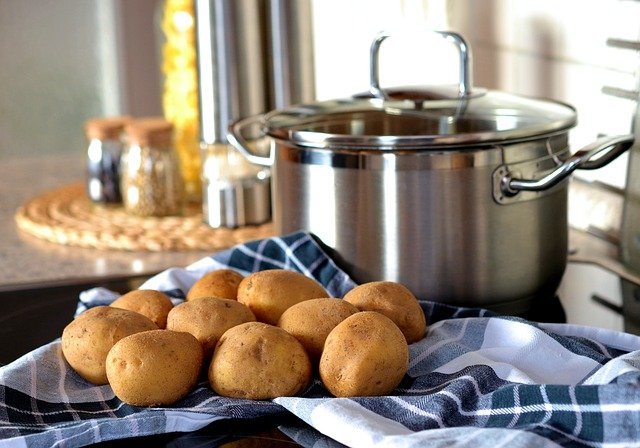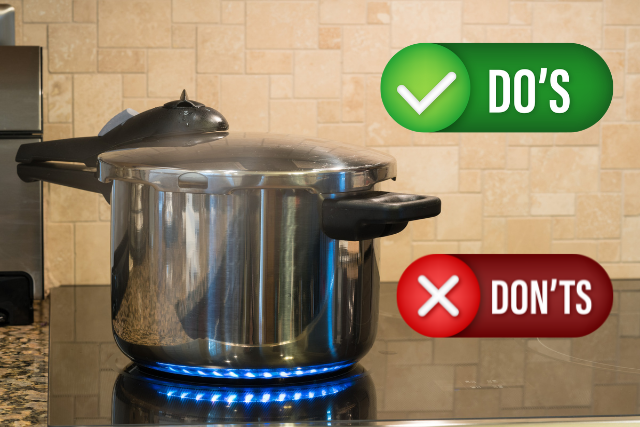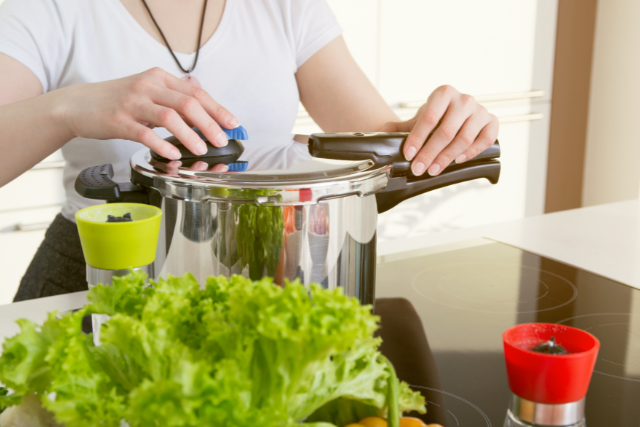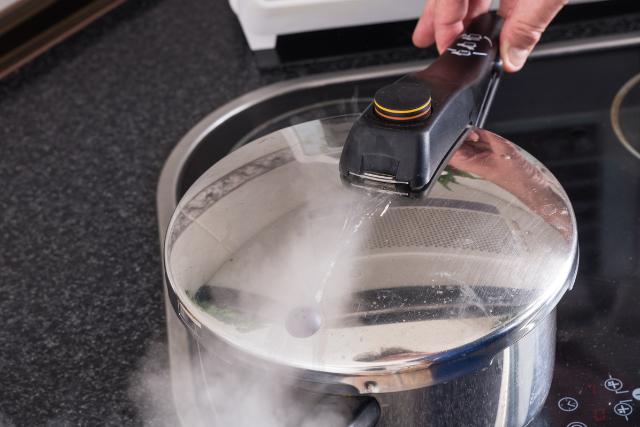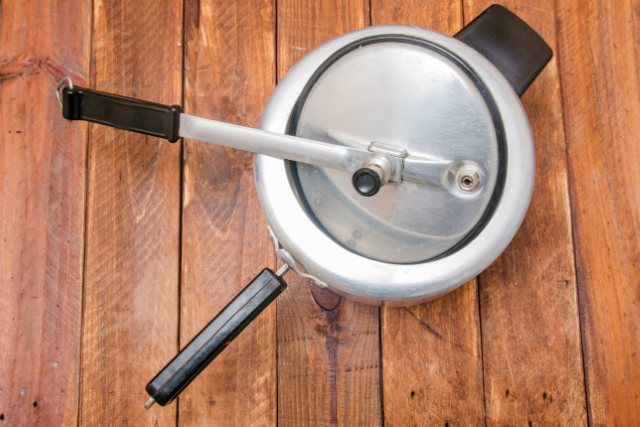Types of Pressure Cookers
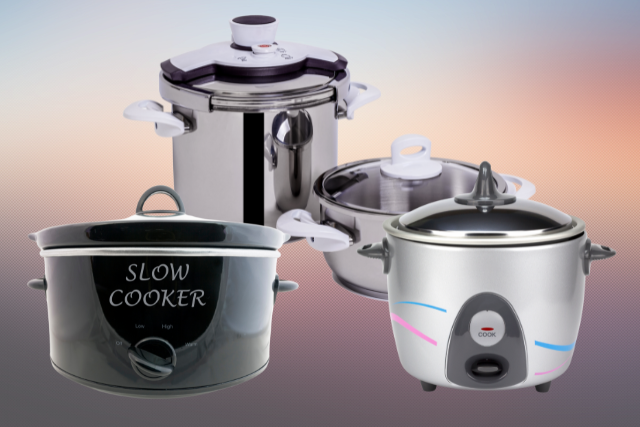
In this article, we will see different types of pressure cookers and the information about their features, advantages, and disadvantages. Pressure cookers have become an essential appliance in every kitchen. Especially, you can not imagine Indian food preparation without pressure cookers. While pressure cookers come in various capacities ranging from 1 to 20 liters, 3L and 5L are the most common.
Pressure cookers operate on the very simple principle – “Build the steam pressure and get the food cooked”. To boost the pressure within a pressure cooker, it is necessary to use water or another type of cooling fluid that is sealed tightly. This pressure produces wet steam, or saturated steam, which pervades food and bombards the particles, raising the atomic temperature and transferring heat far more quickly than dry air or metal. The primary benefit of a pressure cooker is that it cuts down on cooking time. Pressure cookers are classified according to their generations, body material, or features.
Types of Pressure Cookers: Generations of Pressure Cookers
Denis Papin, a physicist, designed the pressure cooker in the seventeenth century, and it works by expelling air from the vessel and holding the steam produced by the boiling liquid inside. Internal pressures are raised, allowing for greater cooking temperatures. This, combined with the rapid thermal heat transfer from the steam, cooks food faster, often in half to a fifth of the time required for traditional boiling. After cooking, the steam pressure is reduced to atmospheric pressure, allowing the vessel to be safely opened.
First-generation
First-generation pressure cookers, often known as “old style” pressure cookers, use a weight-modified or “jiggler” valve to release pressure during operation. Because the valve rattles when extra steam is discharged, some people think they’re loud. Older pressure cookers usually only had one pressure setting, but since the 1960s, several have allowed the user to alter the weight of the valve and hence the pressure. Most pressure cookers nowadays are variations on the first-generation models, with added safety measures including a mechanism that prevents the cooker from being opened until it has completely depressurized.
Second-generation
Second-generation pressure cookers use a proprietary system with a spring-loaded valve that is often hidden from view. Two or more pressure settings distinguish this generation. Some of these pressure cookers don’t emit any steam during operation (non-venting), instead of relying on a rising indicator with markings to indicate the pressure level. Steam is released only the pan is opened or if the heat source is not turned down low enough when the pan achieves the required cooking pressure. Other pressure cookers employ a dial that the operator can advance a few clicks (which changes the spring tension) to modify the pressure setting or relieve pressure; these discharge steam while in use (venting).
Third-generation
“Electric pressure cookers” of the third generation. Pressure cooker on the stovetop with a battery-operated timer. After the stove-top pressure cookers, electric pressure cookers, also known as “third-generation” pressure cookers. An electric heat source that is automatically regulated to keep the operating pressure constant is one of them. A spring-loaded valve is also included.
A timer is built into an electric pressure cooker. Electric pressure cookers are divided into three generations based on their capacity to manage the cooking process:
- Electric pressure cookers of the first generation, having a mechanical timer. There is no option for delayed cooking.
- Electric pressure cookers of the second generation come with a computerized controller. When the working pressure is attained, delayed cooking is available, and the controller displays a countdown timer. These electric pressure cookers also offer smart programming with preset cooking periods and settings based on heating intensity, temperature, pressure, etc.
- Electric pressure cookers of the third generation offer Multifunctional pressure cooking. They are also known as multicookers. These multicookers offer the following functionalities including pressure cooker, saute/browning, slow cooker, rice cooker, egg cooker, yogurt maker, steamer, sous vide, canner, and stockpot warmer. In short, multicookers are replacing several other appliances in your kitchen, and help you to save space on the kitchen countertop and achieve ease of operations.
Types of Pressure Cookers: Body Material
1. Aluminum Pressure Cooker
The first pressure cookers on the market were entirely made of aluminum. Aluminum interiors are found in a large number of pressure cookers available on the market. This is due to the fact that it is a plentiful metal that is also incredibly inexpensive and adaptable. Aluminum also does a fantastic job of uniformly distributing heat on a cooking surface. Aluminum pressure cookers are cheaper, cook faster, consume less fuel.
Because aluminum heats up quickly and reacts easily with acidic vegetables and foods, it’s best to avoid cooking with it. Your immune system is affected by these chemical processes. Tough anodized aluminum pressure cookers and jars are now available to solve this problem. However, the anodization coating has a shelf life and can deteriorate over time due to use, hand washing, and other factors.
Advantages:
- An aluminum pressure cooker is the most cost-effective pressure cooker.
- These cookers cook food rapidly and efficiently because aluminum is a superb conductor of heat.
- These cookers are fuel-efficient because the food is cooked quickly.
- Because of their lightweight, they are easily transportable.
Disadvantages:
- Comparatively aluminum pressure cookers are less durable.
- As compared to stainless steel pressure cookers, aluminum pressure cookers are not strong and sturdy. The aluminum surface can easily bend or get dented.
- They do not give corrosion resistance. A salt stain on their surface can be caused by using harsh water on them.
- Because aluminum reacts with acidic spices like citric acid and turmeric, the food cooked in these cookers is toxic, resulting in a host of health issues.
- You’ll need a metal scrub to clean these cookers because food sticks to the surface.
2. Stainless steel pressure cooker
As the name says, these cookers are made of stainless steel. The stainless steel pressure cookers are elegant in appearance. They offer an easy cleaning experience. Also, stainless steel pressure cookers are stronger than aluminum pressure cookers. There will be no discoloration even after prolonged use. However, the stainless steel pressure cookers can be costly, consume more fuel or gas, take longer times for cooking.
Because stainless steel is a heavier material than aluminum, the pressure cooker’s entire casing and general construction must be more durable and heavy-duty by necessity. A stainless steel pressure cooker is a strong piece of equipment that is exceedingly unlikely to break during its usual use cycle due to its robust build.
The longevity and excellent strength of stainless steel are two of its best qualities. As you might anticipate, this distinguishes stainless steel pressure cookers from aluminum counterparts in two ways: durability and cost. While stainless steel is more robust, it does not conduct heat as effectively as aluminum, so you may discover that cooking in a stainless steel pressure cooker takes longer than cooking in an aluminum one.
Advantages:
- The bodies of these cookers are sturdy and resilient, allowing them to withstand hard conditions and last a long time.
- The food cooked with stainless steel is nutritious and safe since it does not react with the components in the meal.
- Induction cooktops are also compatible with some of these cookers.
- Because heat conduction is slow, heat isn’t evenly dispersed throughout the pressure cooker’s body, protecting you from being burned if you contact it.
- They’re easy to keep clean and maintain their color even after a lot of use.
Disadvantages:
- Meals may take a little longer to cook because stainless steel isn’t a particularly strong conductor of heat.
- Because stainless steel pots are heavy, they require solid handles for safe use.
- They are comparatively more expensive when compared to aluminum pressure cookers.
- Food cooked in these stainless steel pressure cookers should be taken out as soon as possible to avoid overcooking.
3. Hard-Anodized Aluminium Pressure Cooker
Hard Anodised Pressure Cookers are built using the anodization procedure, in which aluminum oxide is coated all over the surface via an electrochemical reaction. They have a bluish-grey hue to them. Hard Anodised Pressure Cookers offers various advantages such as Healthy cooking of food, Lightweight, strong, and durable pressure cookers, Strain-free and corrosion-resistant body material, Better thermal efficiency, Easy cleaning and maintenance, Induction Compatibility, etc.
Hard-Anodized Aluminium Pressure Cookers are more durable. The anodized type includes an extra coating that adds strength to the basic metal, making the pots and pans more solid and strong. Hard-anodized aluminum cookware is the most durable type of cookware on the market today, and it’s twice as strong as stainless steel cookware.
Hard-anodized aluminum cookware provides healthy cooking.
Advantages:
- The food cooked in them is safer due to the added layer of aluminum oxide on their surface.
- The hard anodizing procedure prevents the metal from interacting with acidic substances while still providing a hard, smooth finish. These cookers are non-reactive, non-toxic, and non-staining.
- They’re rust-proof, lightweight, strong, and durable.
- You can prepare meals rapidly in these cookers since they are thermally efficient.
- Because they are made of corrosion-resistant materials, they are stain-free.
- They are quite easy to clean because their surface is less sticky.
- Induction is also supported by the majority of their devices.
Disadvantages:
- This is the most expensive of the three types of pressure cookers available.
- Metal scrapes are not allowed to be used on them since they could scratch them during the cleaning procedure.
Types of Pressure Cookers: Features of Pressure Cookers
Today’s pressure cookers can accomplish a lot of things, or they could be from the first generation, capable of only one pressure setting and not much more. As a result, there are two different types of pressure cookers.
Single-Purpose Pressure Cookers
These pressure cookers are designed to handle a single pressure setting and can, of course, be used to prepare any food, but the outcome is difficult to predict. By design, they might be electric or even valve-based stovetops. In fact, many pressure cookers for canning are simple designs with few extra features. Newer cookers, on the other hand, have pressure indications or gauges that alert you when things aren’t going as planned.
Multi-Purpose Pressure Cookers
These pressure cookers are made to do more than one thing. They may steam and sear in addition to cooking. These cookers have a variety of inserts, choices, and temperature and pressure settings. The ability to convert multi-purpose pressure cookers into slow cookers or rice cookers is common. In fact, these are probably only worthwhile expenditures if you plan on multitasking.
Multicookers very well bridge the gap between cooking methods and the time required by allowing the user to select from a variety of cooking options for various foods. The multi cooker’s electric pressure cooker and slow cooking functions can both be used to produce a stew. With a multi-cooker, you can turn inexpensive pieces of meat and ingredients like dried beans into wonderful recipes. You’ll use less energy than if you cooked in the oven or on the stovetop because they cook so quickly.
Modern Trends in Pressure Cookers

Final Words
In brief, knowing the sort of pressure cooker and its capabilities is essential when purchasing one. A pressure cooker is an essential kitchen tool for quick and healthful cooking. Meanwhile, with so many various types of pressure cookers available, deciding which one to buy can be difficult. Looking at healthy cooking and durability, hard-anodized aluminum pressure cookers get an extra advantage. However, if you desire a more versatile pressure cooker, electronic pressure cookers usually have multiple functions. Stovetop pressure cookers are a fantastic alternative to electric pressure cookers because they are speedier.

